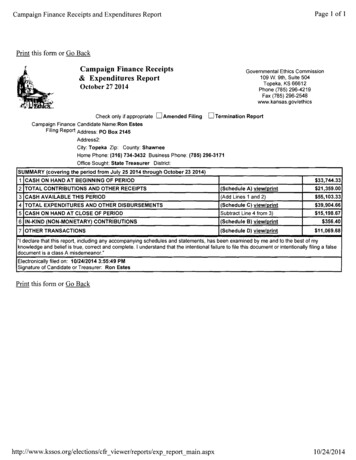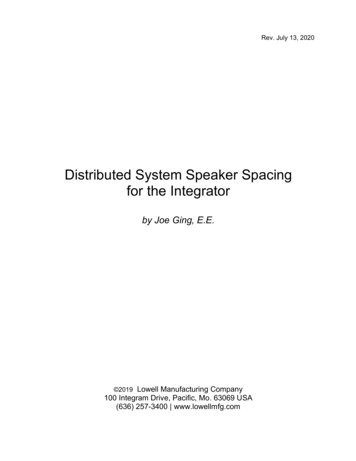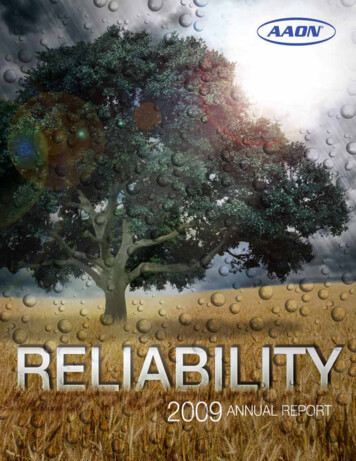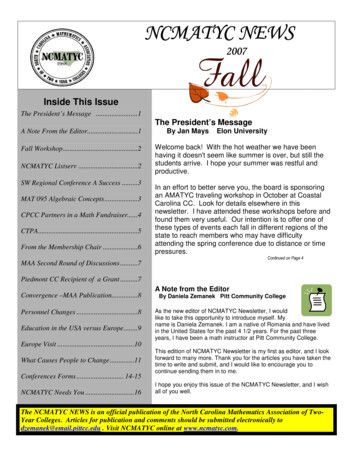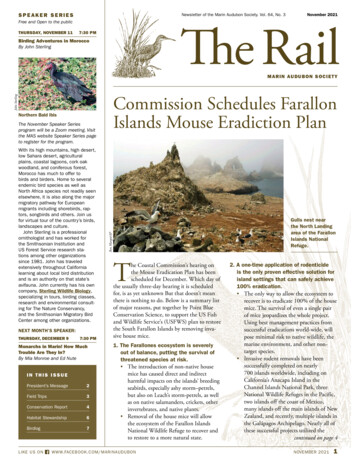
Transcription
SPEAKER SERIESNewsletter of the Marin Audubon Society. Vol. 64, No. 3THURSDAY, NOVEMBER 11November 2021The RailFree and Open to the public7:30 PMBirding Adventures in MoroccoBy John SterlingMAR I N A U D UB ON S O CIE TYJohn SterlingCommission Schedules FarallonIslands Mouse Eradiction PlanNorthern Bald IbisWith its high mountains, high desert,low Sahara desert, agriculturalplains, coastal lagoons, cork oakwoodland, and coniferous forest,Morocco has much to offer tobirds and birders. Home to severalendemic bird species as well asNorth Africa species not readily seenelsewhere, it is also along the majormigratory pathway for Europeanmigrants including shorebirds, raptors, songbirds and others. Join usfor virtual tour of the country’s birds,landscapes and culture.John Sterling is a professionalornithologist and has worked forthe Smithsonian Institution andUS Forest Service research stations among other organizationssince 1981. John has traveledextensively throughout Californialearning about local bird distributionand is an authority on that state’savifauna. John currently has his owncompany, Sterling Wildlife Biology,specializing in tours, birding classes,research and environmental consulting for The Nature Conservancy,and the Smithsonian Migratory BirdCenter among other organizations.NEXT MONTH’S SPEAKER:THURSDAY, DECEMBER 97:30 PMMonarchs in Marin! How MuchTrouble Are They In?By Mia Monroe and Ed NuteIN THIS ISSUEPresident’s Message2Field Trips3Conservation Report4Habitat Stewardship6Birdlog7LIKE US ONGulls nest nearthe North Landingarea of the FarallonIslands NationalRefuge.Ben Margot/APThe November Speaker Seriesprogram will be a Zoom meeting. Visitthe MAS website Speaker Series pageto register for the program.The Coastal Commission’s hearing onthe Mouse Eradication Plan has beenscheduled for December. Which day ofthe usually three-day hearing it is scheduledfor, is as yet unknown But that doesn’t meanthere is nothing to do. Below is a summary listof major reasons, put together by Point BlueConservation Science, to support the US Fishand Wildlife Service’s (USFWS) plan to restorethe South Farallon Islands by removing invasive house mice.1. The Farallones ecosystem is severelyout of balance, putting the survival ofthreatened species at risk. The introduction of non-native housemice has caused direct and indirectharmful impacts on the islands’ breedingseabirds, especially ashy storm–petrels,but also on Leach’s storm-petrels, as wellas on native salamanders, crickets, otherinvertebrates, and native plants. Removal of the house mice will allowthe ecosystem of the Farallon IslandsNational Wildlife Refuge to recover andto restore to a more natural state.WWW.FACEBOOK.COM/MARINAUDUBON2. A one-time application of rodenticideis the only proven effective solution forisland settings that can safely achieve100% eradication. The only way to allow the ecosystem torecover is to eradicate 100% of the housemice. The survival of even a single pairof mice jeopardizes the whole project.Using best management practices fromsuccessful eradications world-wide, willpose minimal risk to native wildlife, themarine environment, and other nontarget species. Invasive rodent removals have beensuccessfully completed on nearly700 islands worldwide, including onCalifornia’s Anacapa Island in theChannel Islands National Park, threeNational Wildlife Refuges in the Pacific,two islands off the coast of Mexico,many islands off the main islands of NewZealand, and recently, multiple islands inthe Galápagos Archipelago. Nearly all ofthese successful projects utilized thecontinued on page 4NOVEMBER 20211
Phone numbers are in the 415 area code unlessotherwise noted. Questions? Please contact theappropriate Board member.PresidentVice PresidentBarbara Salzman 924-6057Doug Waterman 506-4675SecretaryAnn Thomas 924-9559TreasurerLelia Lanctot 924-6138ConservationRoger Harris 510/710-9120Barbara Salzman 924-6057Field TripsOpenMembership ChairBob Hinz 383-8688Contact Bob for membership problemsor questions.Outreach, WebsiteElyse Omernick 694-2320Speaker SeriesMissy Crowe 264-7823Special ProjectsNominatingEditor, The RailJude Stalker 680-6291Roger Harris 510/710-9120Doug Waterman 506-4675Property ManagementEd Nute 669-7710Volunteer CoordinatorOpenBAAC RepsAt-large DirectorBarbara Salzman 924-605Doug Waterman 506-4675Lowell Sykes 388-2821D IRE C T O R S M EET IN GSMeetings open to members. 6:30 PM, FirstTuesday of the month. Meetings are currentlyheld online via Zoom. If you wish to participateplease call 924-6057.MAS telephone: 721-4271 (for messages only)Marin Audubon Society is a nonprofit 501(c)(3)organization. All memberships and contributionsare tax-deductible to the extent allowed by law.The Rail is published ten times a year by theMarin Audubon Society on 100% recycledpaper; edited by Doug Waterman, dglswtrmn@gmail.com, 506-4675; assisted by other members of MAS; and designed by Studio NaCl(www.studionacl.com). 2021 Marin Audubon SocietyWebsite: www.marinaudubon.orgMembers can receive The Rail electronicallyinstead of a hard copy by emailingmembershipsecretary@marinaudubon.org.D ON AT I O NS A PPRE CIAT ED!Marin Audubon Society welcomes gifts offunds, stock, or property, and bequests ingeneral, or in honor or memory of someone.Gifts may be directed to any MAS project.Unspecified gifts of more than 500 willbe placed in the Endowment Fund forconservation, the protection of wildlife species,and the preservation and enhancement ofwildlife habitats. Since MAS is an all-volunteerorganization, 100% of your donation goes to itsprojects. All gifts are tax-deductible and will beacknowledged in The Rail, as well as personallyon behalf of the Society. Checks should bemade out and mailed to: Marin AudubonSociety, P.O. Box 599, Mill Valley, CA 94942.MISSION STATEMENTTo conserve and restore naturalecosystems, focusing on birdsand other wildlife and their habitats,for the benefit of humanity andthe earth’s biological diversity.2THE RAILPresident’s LetterBy Barbara SalzmanAs we’re gradually moving out of Covid, ourfield trips are working out well for the mostpart, even though there is limited space. We’relooking forward to expanding the number ofattendees, but not this month. And we haveno plans to change our programs from beingpresented on Zoom.Hurray! As we go to press, the rains havearrived in full force. Our plants are happy, wecan stop irrigating, and look forward to planting new plants later in the rainy season.Christmas Bird Count time will soon behere. We’re planning to hold the SouthernMarin Count this year on New Years day,Saturday, January 1. The West Marin Count hasbeen scheduled for December 18 and the CheepThrills Count in North Marin has been scheduled for December 16. At this time none of thecounts are planning to hold count dinners.Part of the fire debate is what happens toforest areas that have burned. Called post-firelogging, for years this clearing practice of theU.S. Forest Service was to remove burned treesto reduce fuel for future fires. However, fireecologists now say that this practice contributesto the speed a fire moves; dead wood soaks upand retains moisture and interrupts the fireflow, thereby slowing fires and giving peoplemore time to escape. An example is cited ina recent Open Letter to Decision-Makersfrom GEOS Institute, an organization thatuses technical expertise to help build climateresilience in communities. Signed by 370 scientists, including forest ecologist and resourcemanagers, the message is that, with climatechange, we can expect larger landscapes to burnhotter and reduce forest resilience. This happens because soils are compacted, seedlings thatwill naturally regenerate are killed, fire resistantdead and live trees are removed, degrading fishand wildlife habitat, and likely raising fire hazard. With natural habitats under increasing hot,dry windy conditions, we may take a lessonfrom nature’s approach. Before human intervention, burned trees remained in place. Theyreturned nutrients to the soil, harbored insects,and served as foraging places and homes forwildlife. In natural systems, these trees provideprotective cover and support for new growth toregenerate and, as pointed out, slow down firesso people have a better chance to get out of theway. Nature is the great recycler. It makes senseto me to leave burned trees in place.Stay well.Monarch Butterfly SuccessThe milkweed planted on two of MAS propertieshas successfully hosted monarch butterflies, fromegg to adult. Three years ago volunteers startedplanting native narrowleaf milkweed and nectarplants in suitable areas on two of our properties.Milkweed is the host plant for the threatenedmonarch butterfly and contains toxic cardenolides, which provide the monarch caterpillarsand adults some protection from predators.Monarch butterflies are in serious decline.Last year in the west only 2,000 overwinteringmonarchs were counted in all of coastal California. Three years ago the count was around200,000 and in 1997 the count was 1.2 million. This dire situation has been a wakeup calland has served to mobilize many people andorganizations into action. The federal government is finally considering listing the iconicmonarch butterfly as an endangered species.At MAS’s Simmons property at DeerIsland some 160 milkweed seedlings as wellas nectar plants were planted starting inJanuary 2019. About half of the milkweedplants have flowered and set seed. We noticedsome monarch caterpillars this summer butEd NuteBOARD OF DIRECTORSMonarch and chrysalis inside tent enclosurethey seemed to disappear. We attributed thisdisappearance to the marauding flocks of wildturkeys, which like to scratch in the mulch, sowe installed a short fence round some of themilkweed. We have now counted about fourchrysalises which may eclose (emerge) as adults.This year we also planted milkweed at theBahia site. Despite their toxicity one patch wascontinued on page 4LIKE US ONWWW.FACEBOOK.COM/MARINAUDUBON
FIELD TRIPSMAS FIELD TRIPSOpen to the publicIn person field trips have resumed and are open to all fully vaccinated participants. Trips are limited to allow social distancing. Register for trips on the MAS website Field Trips page. Registration is available on the date indicated in the tripannouncements below.WILLOW CREEK ROAD, JennerSaturday, November 13, 20218:30 AM to 12:30 PMWith Teresa and Miles TuffliHead up the Sonoma County coast to birdWillow Creek Road in Jenner. We’ll have thechance for multiple raptor species, includingpotential for Ferruginous Hawk, AmericanKestrel, and maybe even Bald Eagle. Manyyear-round passerines will be frequentingthe willows, alders, and scrub. With a viewof the Russian River, we’ll look for somewaterbirds as well.We’ll meet at the Russian House #1restaurant and bird the road’s entranceon foot. We’ll then move all cars downthe road to a large pullout. We’ll bird thewillows, creek area, and river view on footbefore consolidating cars and continuingdown the road, stopping to bird varioussections. For a peek at the area, checkout Miles and Teresa’s recap of birdingWillow Creek Road back in July: unty-birding-willow-creek-roadNo bathrooms. Heavy rain cancels. Bringbinoculars, layers, sunscreen, water, lunch,or snacks. Please carpool if possible.Registration opens November 4 at 8 AMon MAS website’s Field Trips page. Trip limitis 15 fully-vaccinated participants.DIRECTIONS: Russian House #1 is at 9960Hwy 1, Jenner, CA. It is 9 miles north ofBodega Bay (15–20 minutes), directly alongHwy 1, on the right just before the RussianRiver bridge.SAN FRANCISCO AND SAN PABLO BAYSBOAT TRIPBerkeley MarinaSunday, November 14, 20219 AM to 4 PMWith Roger HarrisSan Francisco Bay, the largest and one ofthe most important estuaries along thePacific Flyway, is our own backyard. Joinus as we cruise from Berkeley toward theGolden Gate Bridge and north into SanPablo Bay, hugging the shorelines andwaters that are home to thousands of wintering birds. We will pass ten islands, undertwo bridges, and up two creeks in four counties in search of migrating and residentwaterfowl, shore-birds and marine mammals. This trip offers water bird and marinemammal viewing in stunning locations, manyof which can only be seen by boat. Dress inlayers. Bring liquids and lunch. Please bringa mask for any time spent inside the cabin.All participants must be fully vaccinated.The trip costs 120. Limited to 25people. Registration begins on October 8 onMAS website’s Field Trips page. If the trip isfull, you may click “Contact Organizer” andrequest to be put on a waitlist.DIRECTIONS: Registered participants willreceive directions to the Berkeley Marina andother instructions prior to the trip.LIKE US ONRODEO LAGOON, Marin HeadlandsWednesday, November 17, 20217:30 AM to noonWith William Legge and David WiechersMid-November is a surprisingly activetime for migrants at this Marin Headlandslocation, as we search for scarcer late fallmigrants including winter wildfowl, loons,grebes and passerine migrants. As always,the weather will determine the focus ofour search on the day. This “hotspot” hasproduced some memorable Marin raritiesin recent Novembers, including TricoloredHeron, Scaly-breasted Munia and RustyBlackbird. We will begin the morning with asea watch and/or visible migration watch at7:30 AM. Those arriving later may join us at8:30 AM for a circuit of the lagoon.Registration opens November 8 at 8AM on MAS website’s Field Trips page. Triplimit is 12 fully-vaccinated participants.There will not be a waiting list. No drop-ins,please.DIRECTIONS: Head south on Hwy 101,taking the last Sausalito exit just before theGolden Gate Bridge. At the exit stop sign,turn right. Go under the freeway, followingthe road to the left. Within 300 feet turn leftat the sign to the Marin Headlands (This isthe only available left turn before you beginthe descent into Sausalito). You should seethe tunnel with the five-minute light. Proceedthrough the tunnel on Bunker Rd to theRodeo Lagoon Parking Lot. Meet by thebridge over the channel to the beach.BAHIA, HORSESHOE POND & RUSH CREEKBirding in MarinSaturday, December 4, 20218:30 AM to mid afternoonWith Jim White and Bob BattaginMAS acquired and restored to tidal actionthe diked bay lands around the residential Bahia neighborhood. As the ebbing tideexposes the mudflats thousands of shorebirds now descend to feed while on theflood tide hundreds of ducks and some gullsfloat, forage and loaf about. The oak-woodedridge stretching from Hwy 101 to Bahia, alsosaved from development by MAS, holds OakTitmice, White-breasted Nuthatch, Hutton’sVireo, at least four woodpecker species andmany sparrows in the winter.Horseshoe Pond (Homeowners Lagoon) atthe southeast end of Topaz is a great placeto look for wintering ducks. Goldeneyes,Scaup, Canvasbacks, Buffleheads, andMergansers seem to like it and it has beenMarin’s best place for Barrow’s Goldeneyesthe last few years.After lunch we plan to take a look at thenearby Rush Creek area from the Airport Rdwhich parallels Hwy 101 north of Atherton.Registration opens November 24 at 8AM on MAS website’s Field Trips page. Triplimit is 15 fully-vaccinated participants.There is no waiting list. No drop-ins, please.DIRECTIONS: From 101 in north Novato takeAtherton Avenue east, take the Y left ontoBugeia which becomes Bahia Drive, near theend at the bottom of the hill take a right ontoTopaz, follow Topaz to its end and park.WWW.FACEBOOK.COM/MARINAUDUBONJEAN AND JOHN STARKWEATHERSHORELINE PARK, San RafaelThursday, December 9, 202111 AM to 1 PMWith Rich Cimino and Janet BodleJoin Rich and Janet for an easy bird walk onlevel ground during the incoming high tidehigh tide. We will bird the shoreline of SanPablo Bay watching for shorebirds on therocks and diving ducks, loons, and grebeson the bay. We will also bird the freshwater ponds (Spinnaker Lagoon) looking forwintering dappling ducks, warblers, Whitecrowned Sparrow. Bring your scope, water,and snacks. No restrooms are available atthe bird walk. Meet in the parking lot forthe Jean and John Starkweather Shorelinetrailhead. Heavy rain will cancel.Registration opens November 29 at 8 AMon MAS website’s Field Trips page. Trip limitis 20 fully-vaccinated participants. There willnot be a waiting list. No drop ins, please.DIRECTIONS: From the north, take Hwy101 to the Bellam Blvd exit. Turn left onBellum then right on East Francisco Blvd,which parallels I-580. Head east (toward theRichmond/San Rafael Bridge for about 1-1/2miles. You will see a Bay Café sign at the BayPark Center. Turn left on Pelican Way thenright to the trailhead parking area. From thesouth you can take the exit to the San RafaelBridge getting off at the last Marin exit, theSan Quentin exit. For GPS, use the Bay Caféaddress, 2165 Francisco Blvd, San Rafael.COSUMNES RIVER PRESERVE, GaltSaturday, December 11, 20211 to 5:30 PMWith Kurt RademacherAt the junction of the Great Central Valleyand Delta, the Cosumnes River Preserve isa 46,000-acre conservation project acquiredand jointly managed through the collaborationof a number of conservation organizationsand agencies. Here, the last undammedriver on the west slope of the Sierra still routinely floods up in winter, fostering bountifulhabitats of wetlands, savannah and riparianforest for wintering birds. Greater and LesserSandhill Cranes are a highlight of our tour,and we’ll end up at Staten Island for sundown to witness the spectacle of some 15%of the Pacific Flyway’s cranes noisily settlingdown for their nightly roost.Come prepared with warm clothing forchangeable weather including rain and mudfor “Crane-down.”Registration opens December 1 at 8 AMon MAS website’s Field Trips page. Trip limitis 15 fully-vaccinated participants. There willnot be a waiting list. No drop ins, please.DIRECTIONS: We'll meet at the CosumnesRiver Preserve Visitor Center parking lot at13501 Franklin Blvd, Galt. Allow about twohours from Central Marin via Hwys 37, 80and 12 through Rio Vista to I-5, then north toTwin Cities Rd. exit. (Or you can take I-80 toSacramento, then south on I-5 to Twin CitiesRd. exit.) On Twin Cities Rd. proceed eastbriefly to turn right on Franklin Rd about 1.7miles to the parking area.NOVEMBER 20213
CONSERVATIONFarallon Islandscontinued from page 1techniques proposed for the SouthFarallon Islands house mouseeradication. The USFWS will follow lessonslearned from successful eradicationsand will implement hazing and othermeasures to minimize any potentialnegative impacts on non-targetspecies.3. The research and planning for thisproject have been one of the mostcomprehensive, transparent, andscientifically rigorous processes ofany ecological restoration project. Selection by the USFWS of a shortterm, limited use of the rodenticidebrodifacoum, was carefully consideredover ten years, subject to rigorousreview by outside experts andagencies, and included extensivepublic input. After more than ten years of carefulstudy, the USFWS produced ascientifically rigorous EIR, includingmany peer-reviewed scientific papers,extensive research and field tests,accompanied by lab testing andmodeling by the USFWS and itspartners, to ensure minimal risk tonative wildlife.This project has broad and diversesupport from conservation, science, andwildlife rehabilitation organizations. Projectopponents have been speaking at almostevery recent Coastal Commission meetingevery month. We’ve been told that it’slikely to be a close vote and that every bitof public support we can show will help.Public support for the Anacapa removalproject was instrumental in its success.We need to repeat that support for theFarallones.WHAT YOU NEED TO DO:Only one more month to give testimonybefore the Commission at “open publiccomment period” that occurs at thebeginning of each meeting (9 – 10 AM)for items NOT on the agenda. The nextmeetings will be November 17 – 19.You must sign up in advance, by 7 PMthe night before is recommended. Goto the Commission’s website at www.coastal.ca.gov. Under “Meetings”on the top banner, click on “MonthlyAgenda” and then click on the button4THE RAIL“submit a speaker request here.” It’svery straightforward! Public commentsare limited to 2 minutes. It is advisableto write out your comments in advance.Speakers can use PowerPoint slidesand videos if you coordinate with CCCstaff. Or you can provide written oremail comments.SAN GERONIMO VALLEY DRAFTSTREAM AND CREEKSIDEORDINANCE RELEASEDThe Marin County CommunityDevelopment Agency has released a draftordinance intended to comply with theSuperior Court’s April 9, 2021 ruling afteryears of law suits and decisions in favor ofthe plaintiffs, the Salmon Watershed andProtection Network (SPAWN). That ruling requires the county to formulate, adopt,and implement an ordinance to mitigatepotentially significant adverse impacts tosalmonids habitat and survival.At issue is development in the SanGeronimo Valley. San Geronimo Creekflows through the Valley and is an important tributary of Lagunitas Creek that iscritical habitat for endangered Coho Salmonand important habitat for Steelhead. Moredevelopment brings increased impervious surfaces, loss of vegetation and otherimpacts. This impacts winter flows andwater quality and consequently the fish,birds and other wildlife that depend on thecreek.The Marin County CommunityDevelopment Agency’s draft ordinance isbased on the Marin Countywide Plan’sStream and Creek Area (SCA) ordinance.While the changes are improvements overcurrent conditions, there are deficienciesand uncertainties. Some of our concerns arediscussed below.Our first concern is about the purposestatement: “to preserve the natural heritageof and adverse physical effects that mightresult from unplanned and inappropriatedevelopment design or placement are minimized or eliminated.” The purpose shouldexplicitly reference the creek as critical habitat for the endangered Coho Salmon andessential habitat for Steelhead and other fishand wildlife.The draft ordinance describes the SCA,as it is described in the Countywide Plan,as including lands 100 feet from top of thebank or 50 feet from the edge of riparianvegetation, whichever is greater. No development is allowed in this area with thefollowing exceptions:1. Development on parcels that fall entirelywithin the SCA is allowed. The Countyshould state how many parcels, theirsize and location, that fall into thiscategory to convey the potential impactsof developing these parcels in the creekbuffer.2. A 500-foot addition to existingstructures as long as it does not extendinto the SCA. This is a large expansionand it is not clear if it would be formultiple buildings or whether it includesimpervious surfaces, e.g. patios, that arenot buildings.3. Removal of pyrophoric vegetation. Thereshould not be many phyrofidic plants, ifany, in SCA’s because riparian vegetationonly grows in wet areas and is notparticularly flammable. The list shouldbe provided.The ordinance suggests a mitigationbank which MAS opposes. Instead, thecounty, or even an environmental organization, could keep a running list of potentialmitigation sites.The ordinance should require inspectionsand enforcement. Enforcement for permitviolations within the SCA should includefines, removing structures built in violationof permits, and restoring vegetative habitat.Provisions of the proposed San GeronimoValley ordinance would apply only to development within the San Geronimo Valleybut will set the stage for strengthening ordinances elsewhere in the county. So theyshould be of broad interest.WHAT YOU CAN DO:Attend the Marin County PlanningCommission’s Workshop on November8, to ask questions or offer youropinion, and public hearing onDecember 13. Planning Commissionreview is expected to extend throughJanuary. Hearings before the Board ofSupervisors will take place in Februaryand March, 2022.POINT REYES RECORD OFDECISIONWe have now reviewed the Record ofDecision (ROD) and it is indeeddisappointing. The most distressing part iscontinued on page 5LIKE US ONWWW.FACEBOOK.COM/MARINAUDUBON
that it solidifies the permanent presence ofranching at Point Reyes National Seashoreeven if the current families do not want tooperate their ranches.The succession policy in the RODstates it will: “authorize continued multigenerational ranch operations or otheradaptive uses within the Ranchland Zonein a manner that supports the Park’s naturaland cultural resources management objectives and is consistent with revised ”(Alternative B).Prior to release of the ROD, theNational Park Service (NPS) signed anagreement with the Federated Indians ofthe Graton Rancheria (FIGR) “to expandtheir engagement in the stewardship of theland.” The press release states that the “Theselected action incorporates tribal viewsand traditional ecological knowledge intothe management of tule elk and ranch landsin the GMPA (General Management PlanArea) planning area.”According to the Succession Policy,which is a separate document from theROD, in cases where an existing ranchfamily no longer wishes to renew its lease,the NPS would consider uses consistentwith revised Alternative B and, in coordination with FIGR, would issue a request forproposals for grazing from 1) other currentpark ranch operators, 2) long-term parkranch employees, or 3) an FIGR identifiedoperator. Although all must demonstratean ability to meet identified performanceconditions, there is no option to returnranchlands to natural habitats.Revised conditions for ranchers in theROD include:Slight modification in the process for infrastructure upgrades in Ranch OperationsAgreements (ROA) is included to ensurecompliance with conditions required by theCoastal Commission to develop a strategyand timeline for improving water quality.Also ranch operators will be required to: Modify feeding strategies to reduce conflicts by reducing elk access to hay thatare in elk-frequented areas. Identify and plan maintenance requirements for stock ponds documented asCalifornia red-legged frog habitat Implement the US Fish and WildlifeService-approved Raven ManagementProgram, Evaluate infrastructure conditions toLIKE US ONaddress deferred maintenance on thehistoric ranch infrastructure. Limit sileage production on beefranches(would be reduced by 280 acres).Changed requirements for the five dairyranches: Commit to upgrade modernization ofmanure and nutrient management toprotect water quality. Cease to operate if rancher does not orcannot modernize, but they could convert to beef ranching.Changes in elk management:We trust the FIGR has strong ecological integrity because only their views arerecognized, and there is not much in theROD about protecting habitat or speciesexcept for elk management, a brief mentionof Snowy Plover and discussions of compliance with wildife agencies in attachments.Although lots of specifics about culturalresources are included the ROD shows littleinterest in the Seashore’s natural resourcesthat existed long before the historic buildings at Point Reyes.Much can happen on 25,500 acres ofNPS will take a graduatedapproach to discourageestablishment of new herds:haze back to original location,monitoring and possibly lethalremoval in coordination withFIGR and CDFW. Manage Drake’s Beachherd to maintain a population of 140 animals (upfrom 120 in EIS), eitherexisting core area orexpanding to adjacentungrazed area. Allow Limantour herd toexpand in population anddistribution. Use of hazing to discouragefemales from occupyingranch areas. Enhance forage for elk byplanting plants elk like.Changes in diversification: Keeping chickens is prohibited except that NPSstaff has the ability to issueE Ranch Dumpsitepermits allowing chickens. Sileage production isreduced.ranchlands, particularly if there is little Unchanged from Alternative B is theon-the-ground oversight and enforcement.limitation to 50 sheep and 66 goats andThe recently published photo of a dumprestriction farm stays to two guest rooms, on the E Ranch is an example of what candepending on water availability. Thesehappen when there is inadequate oversight.uses had previously not been allowed inInterestingly there is no reference in thethe park.ROD or EIS prohibiting use of the lands asdumps. We hope such a prohibition will beThe ROD also identifies ways toaddressed in the ROAs.improve visitor experiences; trails toAssistant Secretary of the Interior forimprove visitor use for biking, hikingFishand Wildlife and Parks in the NPSand equestrian uses. They claim no newpressrelease that “the ROD adequatelytrails will be constructed but will be trailprotects the diverse natural resources of theimprovements which will bring increasedPark and it serves as a model where wilderuse of the farm roads and bike trails alongneeds can exist side by side with ranching.”roads. More people and uses over the ranchWe don’t see sufficient assurances this willlands are likely to result in more impacts onnative wildlife.be the case.WWW.FACEBOOK.COM/MARINAUDUBONNOVEMBER 20215 Jocelyn KnightPoint Reyes Record of Decisioncontinued from page 4
It’s too early in the season to plantso we will be focused on removinginvasive non-native plants. We arepleased that stinkwort (Dittrichiagraveolens) appears to have beeneliminated at both Triangle Marshand the Corte Madera EcologicalReserve expansion site. Salsolasoda, an annual invasive species, isstill present, and this will be the lastchance in the season to pull itbefore its seeds mature. Hardinggrass is growing again even withoutearly rain, and we will be diggingsome of that as well as probablybristly ox-tongue.Act locally and join us on aworkday. California’s wild plants andanimals need your help. We all makea difference.Volunteer WorkdaysTriangle Marsh, East Corte Madera:First Saturdays: November 6,December 4Meet at 10 AM on ParadiseDrive directly across from the RingMountain Phyllis Ellman trailheadnear the Montessori School.Corte Madera Ecological Reserve:
Marin Audubon Society is a nonpro!t 501(c)(3) organization. All memberships and contributions are tax-deductible to the extent allowed by law. The Rail is published ten times a year by the Marin Audubon Society on 100% recycled paper; edited by Doug Waterma


